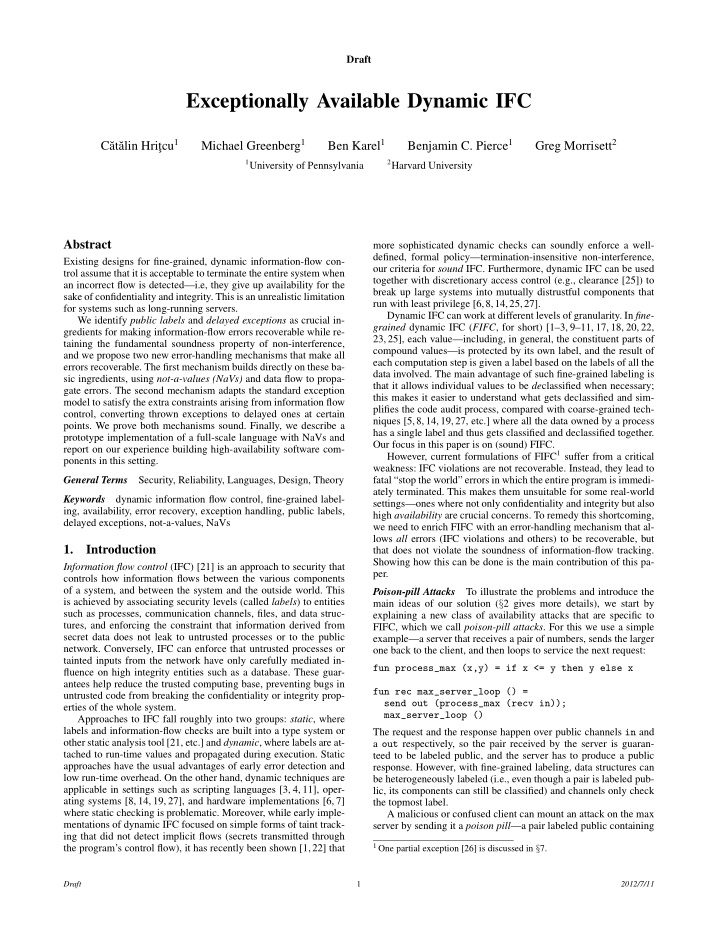



Draft Exceptionally Available Dynamic IFC ¸cu 1 Michael Greenberg 1 Ben Karel 1 Benjamin C. Pierce 1 Greg Morrisett 2 C˘ at˘ alin Hrit 1 University of Pennsylvania 2 Harvard University Abstract more sophisticated dynamic checks can soundly enforce a well- defined, formal policy—termination-insensitive non-interference, Existing designs for fine-grained, dynamic information-flow con- our criteria for sound IFC. Furthermore, dynamic IFC can be used trol assume that it is acceptable to terminate the entire system when together with discretionary access control (e.g., clearance [25]) to an incorrect flow is detected—i.e, they give up availability for the break up large systems into mutually distrustful components that sake of confidentiality and integrity. This is an unrealistic limitation run with least privilege [6,8,14,25,27]. for systems such as long-running servers. Dynamic IFC can work at different levels of granularity. In fine- We identify public labels and delayed exceptions as crucial in- grained dynamic IFC ( FIFC , for short) [1–3, 9–11, 17, 18, 20, 22, gredients for making information-flow errors recoverable while re- 23, 25], each value—including, in general, the constituent parts of taining the fundamental soundness property of non-interference, compound values—is protected by its own label, and the result of and we propose two new error-handling mechanisms that make all each computation step is given a label based on the labels of all the errors recoverable. The first mechanism builds directly on these ba- data involved. The main advantage of such fine-grained labeling is sic ingredients, using not-a-values (NaVs) and data flow to propa- that it allows individual values to be de classified when necessary; gate errors. The second mechanism adapts the standard exception this makes it easier to understand what gets declassified and sim- model to satisfy the extra constraints arising from information flow plifies the code audit process, compared with coarse-grained tech- control, converting thrown exceptions to delayed ones at certain niques [5,8,14,19,27, etc.] where all the data owned by a process points. We prove both mechanisms sound. Finally, we describe a has a single label and thus gets classified and declassified together. prototype implementation of a full-scale language with NaVs and Our focus in this paper is on (sound) FIFC. report on our experience building high-availability software com- However, current formulations of FIFC 1 suffer from a critical ponents in this setting. weakness: IFC violations are not recoverable. Instead, they lead to General Terms Security, Reliability, Languages, Design, Theory fatal “stop the world” errors in which the entire program is immedi- ately terminated. This makes them unsuitable for some real-world Keywords dynamic information flow control, fine-grained label- settings—ones where not only confidentiality and integrity but also ing, availability, error recovery, exception handling, public labels, high availability are crucial concerns. To remedy this shortcoming, delayed exceptions, not-a-values, NaVs we need to enrich FIFC with an error-handling mechanism that al- lows all errors (IFC violations and others) to be recoverable, but 1. Introduction that does not violate the soundness of information-flow tracking. Showing how this can be done is the main contribution of this pa- Information flow control (IFC) [21] is an approach to security that per. controls how information flows between the various components of a system, and between the system and the outside world. This Poison-pill Attacks To illustrate the problems and introduce the is achieved by associating security levels (called labels ) to entities main ideas of our solution ( § 2 gives more details), we start by such as processes, communication channels, files, and data struc- explaining a new class of availability attacks that are specific to tures, and enforcing the constraint that information derived from FIFC, which we call poison-pill attacks . For this we use a simple secret data does not leak to untrusted processes or to the public example—a server that receives a pair of numbers, sends the larger network. Conversely, IFC can enforce that untrusted processes or one back to the client, and then loops to service the next request: tainted inputs from the network have only carefully mediated in- fun process_max (x,y) = if x <= y then y else x fluence on high integrity entities such as a database. These guar- antees help reduce the trusted computing base, preventing bugs in fun rec max_server_loop () = untrusted code from breaking the confidentiality or integrity prop- send out (process_max (recv in)); erties of the whole system. max_server_loop () Approaches to IFC fall roughly into two groups: static , where labels and information-flow checks are built into a type system or The request and the response happen over public channels in and other static analysis tool [21, etc.] and dynamic , where labels are at- a out respectively, so the pair received by the server is guaran- tached to run-time values and propagated during execution. Static teed to be labeled public, and the server has to produce a public approaches have the usual advantages of early error detection and response. However, with fine-grained labeling, data structures can low run-time overhead. On the other hand, dynamic techniques are be heterogeneously labeled (i.e., even though a pair is labeled pub- applicable in settings such as scripting languages [3, 4, 11], oper- lic, its components can still be classified) and channels only check ating systems [8, 14, 19, 27], and hardware implementations [6, 7] the topmost label. where static checking is problematic. Moreover, while early imple- A malicious or confused client can mount an attack on the max mentations of dynamic IFC focused on simple forms of taint track- server by sending it a poison pill —a pair labeled public containing ing that did not detect implicit flows (secrets transmitted through 1 One partial exception [26] is discussed in § 7. the program’s control flow), it has recently been shown [1,22] that Draft 1 2012/7/11
Recommend
More recommend